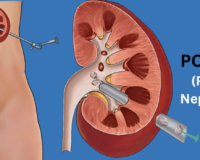What is PCNL (Percutaneous Nephrolithotomy ) Surgery & why it’s done?
Crystallization of chemical components in the urine can lead to the formation of kidney stones in the urinary tract, which is then passed on to the kidneys. PCNL is a technique that is used to remove certain stones in the kidney or upper ureter (the tube that drains urine from the kidney to the bladder) that are too large for other forms of stone treatment such as shock wave lithotripsy or ureteroscopy. These stones are removed using a technique called percutaneous nephrolithotomy.
Percutaneous nephrolithotomy (PCNL) is a procedure used to get rid of kidney stones that can’t pass on their own. “Percutaneous” means through the skin. During the procedure, a path is made from the back skin to the kidney. A surgeon locates and removes kidney stones using microscopic instruments through a back tube.
Why is PCNL done?
When these conditions are present, percutaneous nephrolithotomy is often recommended:
- Kidney stones, particularly those that are large, might obstruct more than one of the branches in the collecting system of the kidney. These particular kidney stones are referred to as staghorn kidney stones.
- Stones in the kidney have a diameter that is greater than 0.8 inches (or 2 cm).
- There are significant stones located in the tube that connects a kidney to the bladder (ureter).
- Other treatments have been tried and didn’t work out.
Pre-PCNL?
Meet with a doctor before percutaneous nephrolithotomy. They’ll check your vitals and health (temperature, pulse and blood pressure).
Discuss your prescription and OTC drugs with your doctor. Herbal supplements. Aspirin, anti-inflammatory medicines, herbal supplements, and blood thinners increase bleeding risk. Before quitting drugs, consult a doctor.
Inform your doctor of any allergies. List all allergens. Latex, meals, pharmaceuticals, and skin cleansers like iodine or isopropyl alcohol are examples.
Your doctor will also offer you pre-PCNL diet and drinking instructions. Before surgery, don’t eat or drink after midnight. Take drugs with a drink of water.
How the whole process is done?
PCNL procedure has been done on a lot of people over the last few years, and it is now the standard of care for people with large, very hard kidney stones that don’t respond to other treatments. So, it has replaced open surgery for kidney stones in the vast majority of cases.
Most of the time, the surgery takes between 1-2 hours. The surgery is done by making a small cut about 1 cm long on the side of the patient (Figure 1). With the help of an x-ray, a tube is put into the kidney through the cut. Then, a small telescope is put through the tube to look at the stone, break it up, and take it out of the body. If needed, a laser or another device called a lithotripter could be used to break up the stone before it can be removed. Compared to open stone surgery, this procedure has led to much less pain after the surgery, a shorter hospital stay, and a faster return to work and daily activities.
This method is also more likely to get rid of all the stones in just one session than other methods like extracorporeal shock wave lithotripsy (ESWL), which often takes more than one try.
After the surgery
After the procedure, you might have to stay in the hospital for 1 to 2 days. After surgery, you may need to stay away from heavy lifting, pushing, or pulling for 2 to 4 weeks. After about a week, you might be able to go back to work.
If surgery left you with drainage tubes in your kidney, you’ll need to watch for any bleeding. Go to the emergency room if you see blood or thick clumps of blood that look like ketchup in your urine or drainage tube.
If you get a fever or chills, you should call your regular doctor or the surgical care team. These could be signs of an infection, and you may need to go to the hospital right away. If you are in a lot of pain and painkillers aren’t helping, talk to your doctor or nurse.
What are the risks or problems that can happen with PCNL?
Even surgeries with little damage to the body have risks. Some of the risks of PCNL are:
- Anesthesia risks.
- Healing problems.
- Infection.
- Sticky mass of blood
The Risk or the above problem carry less than 5% of chances in patients, 95% of patients usually don’t have any kind of complications.
How painful is PCNL surgery?
Most people don’t find PCNL as a painful. Sometimes the ureteral stent is the part of the procedure. If you are in pain, your doctor may give you painkillers.
FAQs
Exactly what benefits can percutaneous nephrolithotomy offer?
Percutaneous nephrolithotomy’s main benefit is the removal of kidney stones that don’t pass on their own or can’t be treated with other methods. It is also a noninvasive method of treatment. When compared to open surgeries, the recovery time for minimally invasive procedures is significantly shorter.
Is PCNL regarded as a massive procedure?
Even though PCNL is a minimally invasive surgery that has fewer complications, less of an impact on your health, and helps you to heal faster than open surgery, it is still considered to be moderate rick procedures.
Who is the suitable candidate to undergo a percutaneous nephrolithotomy procedure?
If you have a tiny kidney stone that is unable to pass on its own, a healthcare professional may initially advise laser ureteroscopy or shock wave lithotripsy as a treatment option for you. Patients who are unable to pass a kidney stone on their own and whose stones are too large to be treated with shock wave lithotripsy or laser ureteroscopy are ideal candidates for percutaneous nephrolithotomy (PCNL).
What steps are involved in doing percutaneous nephrolithotomy?
Urologists are the ones that carry out percutaneous nephrolithotomy procedures. Urologists are medical professionals who specialise in the diagnosis, treatment, and surgical management of illnesses and diseases that affect the urinary tract. They will remove the kidney stone by performing a procedure that involves making a small incision (cut) in your back or side to gain access to your kidneys.



